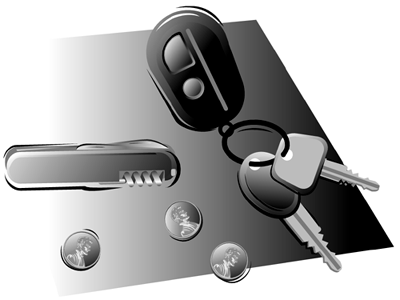Why Software-Based Products Are Different
| Cognitive friction creeps into all software-based products, regardless of their simplicity, and cognitive friction makes them much more difficult to use than equivalent mechanical-age products. As an example, here are the contents of my pants pocket: some coins, my Swiss Army knife, and my car keys. The knife is pure industrial age: You can see how it is built, how it works, and how to work it just by a cursory inspection by manipulation. When you flip open the knife blade, you can see that it is sharp, and you can imagine the power it has for cutting.
The knife has a grand total of six blades, plus a toothpick and tweezers. The use of all of them is readily apparent. I can easily and intuitively discern how to manipulate the knife because of the way it fits my hand and fingers. The knife is a pleasure to use. The keyless entry system accompanying my car keys is a different beast altogether. It only has two push buttons on it, so from a manipulation point of view it is much simpler than the knife. As soon as my hand grips the smooth, black-plastic case, my fingers naturally and intuitively discover the two push buttons, and their use is obvious: Press to activate. Ah, but there is silicon, not steel, behind those buttons, and they are far harder to work than they seem. The large button locks the car and simultaneously arms the alarm. Pressing the button a second time disarms the alarm and unlocks the car. There is also a second, smaller button labeled Panic. When you press it, the car emits a quiet warble for a few seconds. If you hold it down longer, the quiet warble is replaced by the full 100-decibel blasting of the car alarm, whooping, tweeting, yowling, and declaring to everyone within a half-mile that some dolt me has just done something execrably stupid. What's worse, after the alarm has been triggered, the little plastic device becomes functionally inert, and further pressing of either button does nothing. The only way to stop that honking announcement of my palpable stupidity is to walk to my frighteningly loud car, enduring withering stares from passersby, unlock the driver's door with the key, then insert the key into the ignition and twist it. It really makes me feel like an idiot. If my car merely got robbed it would make me feel violated and sad, but it wouldn't make me feel stupid. In my previous book, I stated that the number-one goal of all computer users is to not feel stupid. I further asserted that good interfaces should avoid presenting users with ejection-seat levers intermingled with the controls for common, everyday functions. Here is a classic example of a device that really makes users feel stupid by putting an ejector-seat lever right up front. Accidentally setting off the ejector-seat lever initiates a personally embarrassing episode tantamount to showing up at the office having forgotten your pants. My Swiss Army knife just doesn't have the capability of doing that. Not only can I not imagine a reason why any person would want to use either of the functions on the second button, but I question why the makers of the control didn't take advantage of the golden opportunity to provide me with functions that are desirable and useful.[1]
As much as I appreciate that my car comes with an alarm, there are many times when I want to lock the car without arming the alarm. When I pop into the local Starbucks for some coffee, I don't need the level of protection that I need at, say, the airport. I would really like to have the ability to lock and unlock my car from the remote without involving the alarm system. This would be quite useful when I'm just driving to local shops or dropping my kids off at school. Another quite useful and desirable feature would be an option to support an even more secure locking system. Occasionally, when I return to my previously locked car, I find that it has become unlocked in my absence. This happens when someone with a similar car made by the same manufacturer parks near my car. When that person presses the button to lock his car, it also gives the signal to unlock mine, disarming the alarm, and opening up my car to the depredations of any passing sociopath. This scenario is most disturbing in precisely the situation where it is most likely to occur: in large, urban parking lots, such as at airports, where my car is likely to spend several hours, or even days, exposed to the random distribution of keyless entry systems. It sure would be a useful application of the technology if I could lock and arm my car in such a way that I could unlock and disarm it only by personal application of the metal key in the door. Obviously, I know that the technology exists to do this because that is how the alarm itself is turned off after it is triggered. Unfortunately, the designers of the system made certain that regardless of how I lock the car, anyone's big button can unlock it. The Swiss Army knife is complex and packed with features, some hidden quite cleverly, yet learning and using it is simple, predictable, and intuitive. Using the keyless entry system is difficult, problematic, and capable of instantly embarrassing me. It doesn't do what I want, and it doesn't give me the level of control over my car and its alarm that I consider normal and acceptable. In short, the interaction with the system sucks. It is plain old bad, and I hate it. |
EAN: N/A
Pages: 170
